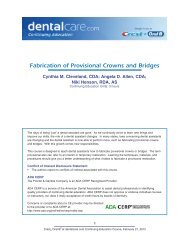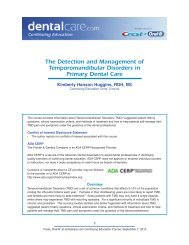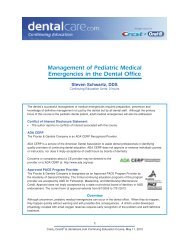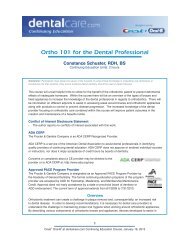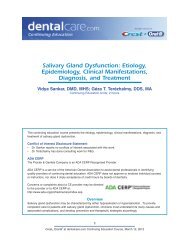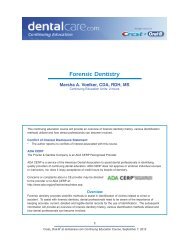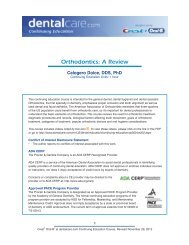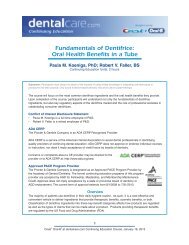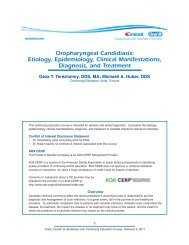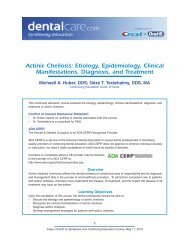CE 421 - Dental Anatomy: A Review - DentalCare.com
CE 421 - Dental Anatomy: A Review - DentalCare.com
CE 421 - Dental Anatomy: A Review - DentalCare.com
You also want an ePaper? Increase the reach of your titles
YUMPU automatically turns print PDFs into web optimized ePapers that Google loves.
Figure 18. Periodontium. Diagram of periodontium which surround<br />
the teeth.<br />
Image courtesy of Illustrated <strong>Dental</strong> Embryology, Histology, and <strong>Anatomy</strong>.<br />
Gingival Unit<br />
The gingival unit consists of the gingiva (soft<br />
tissues that surround the teeth) and the alveolar<br />
mucosa (soft tissues that line the oral cavity).<br />
Gingiva – The gingiva, also known as gum<br />
tissue, surrounds the teeth and can be attached<br />
to the underlying bone (attached gingiva) or<br />
unattached (free gingiva). When healthy, the<br />
gingiva should be firm and well adapted to the<br />
teeth, and have a stippled appearance. This<br />
means that its texture appears similar to an<br />
orange peel. The color of healthy gingiva<br />
depends on the pigmentation of each person, but<br />
in general it should appear light pink.<br />
Alveolar Mucosa – The alveolar mucosa<br />
consists of the tissue inside the cheeks, vestibule<br />
(the space between the lips or cheeks and the<br />
teeth), lips, soft palate, and under the tongue.<br />
This tissue is more movable and is lightly<br />
attached to the underlying bone and muscles. Its<br />
texture is smooth and its color is red to bright red.<br />
Attachment Unit<br />
The attachment unit consists of the cementum,<br />
19<br />
the alveolar bone (bone surrounding the teeth),<br />
and the periodontal ligaments (fibers or ligaments<br />
that anchor and support the teeth in their sockets).<br />
Cementum – The cementum, a tooth tissue<br />
covering the root of the tooth; periodontal ligament<br />
fibers are imbedded in the cementum which serve<br />
the function of anchoring the teeth in their sockets.<br />
Alveolar Bone – The alveolar bone is also called<br />
the alveolar process. It is the bone that forms the<br />
sockets for the teeth.<br />
Periodontal Ligament – The periodontal ligament<br />
is connective tissue arranged into groups of fibers;<br />
these fibers are attached to the cementum, to the<br />
alveolar bone and to the cervical gingivae.<br />
Conclusion<br />
A working knowledge of normal anatomy of the<br />
face and oral cavity is critical for the entire dental<br />
team. This is one of many facets necessary<br />
in providing oral healthcare. Communication<br />
between team members and other healthcare<br />
providers is an important <strong>com</strong>ponent to the overall<br />
health and well being of the dental patient.<br />
Crest ® Oral-B ®<br />
at dentalcare.<strong>com</strong> Continuing Education Course, April 23, 2013



